Introduction
Traumatic spinal cord injuries (TSCI) are among the leading causes of physical and psychosocial impairments.Reference Couris, Guilcher and Munce1, Reference Bárbara-Bataller, Méndez-Suárez, Alemán-Sánchez, Sánchez-Enríquez and Sosa-Henríquez2 TSCI incidence ranges between 10.4 and 83 per million in the developed world.Reference Lenehan, Street and Kwon3 In North America, the reported annual frequency rates for TSCI range from 25 to 93 per million population,Reference Pickett, Campos-Benitez, Keller and Duggal4 while the annual frequency of TSCI admitted to our hospital is estimated at 16 per million population5 based on hospital admissions (77 new cases per year). Due to the long recovery process and consequences on functional abilities, these injuries largely contribute to a high economic burden on the healthcare system.Reference Guilcher, Munce and Couris6
Previous epidemiological studies reported comprehensive and relevant data on TSCI in different Canadian provinces, such as Alberta,Reference Dryden, Duncan Saunders and Rowe7 British Columbia,Reference Lenehan, Street and Kwon3 Manitoba,Reference McCammon and Ethans8 and Ontario,Reference Couris, Guilcher and Munce1, Reference Pickett, Campos-Benitez, Keller and Duggal4, Reference Guilcher, Munce and Couris6 and other countries as well.Reference Leucht, Fischer, Muhr and Mueller9, Reference Tafida, Wagatsuma, Ma, Mizutani and Abe10 These epidemiological studiesReference Couris, Guilcher and Munce1, Reference Lenehan, Street and Kwon3, Reference Pickett, Campos-Benitez, Keller and Duggal4, Reference Guilcher, Munce and Couris6–Reference Tafida, Wagatsuma, Ma, Mizutani and Abe10 mainly focused on incidence, prevalence, cause, and impairment characteristics of TSCI at all spinal levels, with or without evidence of spinal fractures. Spinal fractures were found to be significantly associated with severity of TSCI as described by AIS,Reference Pickett, Campos-Benitez, Keller and Duggal4 resulting in longer treatments for patients and higher healthcare costs.Reference Leucht, Fischer, Muhr and Mueller9 In Canada, TSCI with spinal fractures represent 64%Reference Pickett, Campos-Benitez, Keller and Duggal4 of all TSCI. Moreover, 85% of cases of complete TSCIs had a spinal fracture. Moreover, in the province of Ontario, THINK FIRST Head and Spinal Cord Injury Prevention ProgramReference Pickett, Campos-Benitez, Keller and Duggal4 was launched to raise awareness among motor vehicle users and consequently reduce TSCI. No such prevention program is available in Québec.
Over the years, researchers proposed several fracture classifications to account for the severity and stability of injuries, which are crucial assessment factors to provide appropriate treatments and optimize medical care resources. Magerl et al.Reference Magerl, Aebi, Gertzbein, Harms and Nazarian11 and Aebi et al.Reference Aebi, Arlet and Kebb12 developed the AO classification of spinal fractures based on the pathomorphological characteristics of the injury. Three main categories (types A, B, or C) were established, corresponding to the mechanisms of injury (MOI), namely compression (type A), distraction (type B), and rotation (type C). Using this classification, all fracture injuries can be hierarchically classified into MOI groups (type A, B, or C), subgroups, and specificities, according to their progressive severity and spine levels from C3 to C7Reference Aebi, Arlet and Kebb12 and T1 to L5.Reference Magerl, Aebi, Gertzbein, Harms and Nazarian11
Despite their importance, limited epidemiological data specifically focusing on TSCI with spinal fractures are currently available. A recent study by Wang et al.Reference Wang, Liu and Zhao13 highlighted that a young active population was particularly at risk of TSCI associated with spinal fracture following motor vehicle collisions in China. Other studies also reported the high TSCI risk associated with the young population following motor vehicle accidents.Reference Pickett, Campos-Benitez, Keller and Duggal4, Reference Dryden, Duncan Saunders and Rowe7, Reference Leucht, Fischer, Muhr and Mueller9 However, epidemiological studies on TSCI with or without fractures did not report detailed information regarding the main MOI involved in TSCI. This retrospective study aimed at providing comprehensive data on TSCI with spinal fractures in a level I trauma center in the province of Québec, Canada. More specifically, this study investigated the relationship between the main MOI and other variables such as sex, age, accident causes, injured spinal level, and neurological impairment.
Material and Methods
Retrospective Study Design
The institutional review board approved this retrospective study. This study included patients admitted between 2006 and 2014 to Sacré-Coeur Hospital, the sole level I trauma center for spinal cord injuries (SCI) in Western Quebec (70% of Quebec’s population,14 approximately 5.8 million residents). Inclusion criteria were an admission for TSCI with spinal fracture and presence of luxation, according to the International Classification of Diseases (ICD-10, Clinical Modification Diagnostic Code 806.x: fracture of vertebral column with SCI),Reference McCammon and Ethans8 along any part of the spine. Additionally, available preoperative CT-scan images were mandatory to assess and categorize injuries based on Aebi et al. for the cervical (C3–C7) levelReference Aebi, Arlet and Kebb12 and Magerl et al. for thoracic and lumbar levels.Reference Magerl, Aebi, Gertzbein, Harms and Nazarian11 TSCI with fractures at C1 or C2 levels were included in this study, and classified using the Upper Cervical Classification System.15
Causes of Injuries
Causes of injuries were divided into six categories: cars, vehicles without restraint systems, accidents as pedestrians, high-energy (HE) falls, low-energy (LE) falls, and other causes. Vehicles without restraint systems also termed as unrestrained vehicles were defined as vehicles that do not have a protective or restriction device system. This category comprised motorcycles, bicycles, all-terrain vehicles (ATVs) and snowmobiles. HE falls were falls from a height >2 m,Reference Leucht, Fischer, Muhr and Mueller9 such as falls from buildings, ladders, etc. LE falls were considered for falls <2 m,Reference Leucht, Fischer, Muhr and Mueller9 typically including falls from one’s height, a bed, a seat, etc. Other causes contained miscellaneous accidental situations such as skydiving, accidental drowning, waterskiing, mechanical force impact caused by throwing or the fall of an object, fire or electrical exposure, sport-related collisions, self-harm, etc.
Descriptive Data
The following independent variables were collected: sex, age, cause of injury according to ICD-10,Reference McCammon and Ethans8 affected spinal levels, and MOI.Reference Magerl, Aebi, Gertzbein, Harms and Nazarian11, Reference Aebi, Arlet and Kebb12 Injuries were evaluated using CT-scan images enabling spinal fracture location visualization. Moreover, when information was available, neurologic deficit severity upon arrival at our center was assessed according to the American Spinal Injury Association (ASIA) impairment scale.Reference Magerl, Aebi, Gertzbein, Harms and Nazarian11 Presence of cauda equina syndrome or conus medullaris injuryReference Todd16 was documented when information was available in patients’ medical files.
Statistical Analyses
Statistical analyses were performed using Statistica v7 (Tulsa, Oklahoma, USA). Means and standard deviations were used to describe age distribution. Proportions described categorical data. Correlations were examined between sex, age expressed in the number of patients regrouped in 10-year intervals, cause of injury, MOI, injured spinal level, and level of neurological impairment with Pearson chi-squared tests. Significance level was set at 0.05.
Results
Sex and Age Distribution
This study enrolled 282 patients. The cohort comprised 215 (76.2%) males and 67 (23.8%) females, for a male-to-female ratio of 3.21:1. The mean age of all patients was 42.5 ± 18.7 years (range 15.6–88.0). Among males, the population most at risk was within the 20–49-year range. Females had a peak between 20 and 29 years, and a similar number of affected patients between 0 and 19 years, as well as from 30 to 69 years in each 10-year interval (Figure 1). No significant difference was found between male and female distributions (p = 0.36). Overall, 176 (81.9%) male and 53 (79.1%) female patients with TSCI associated with fracture were aged between 20 and 69 years. Only six patients (2.1% of all patients) were ≥80.

Figure 1: Age distribution of patients: 241 males and 61 females.
Causes of Injury
HE falls were the most common causes of injuries accounting for 28.4%, followed by car accidents (26.2%), ATV accidents (11.7%), LE falls (9.6%), motorcycle (6.7%), bicycle (2.8%), and pedestrian (1.4%) accidents (Figure 2, Table 1). Other causes accounted for 13.1% of accidents, and their detailed frequencies are reported in Table 1. When pooled together, accidents caused by unrestrained vehicles (ATVs, motorcycles, and bicycles) accounted for 21.3% of injuries (Figure 2).
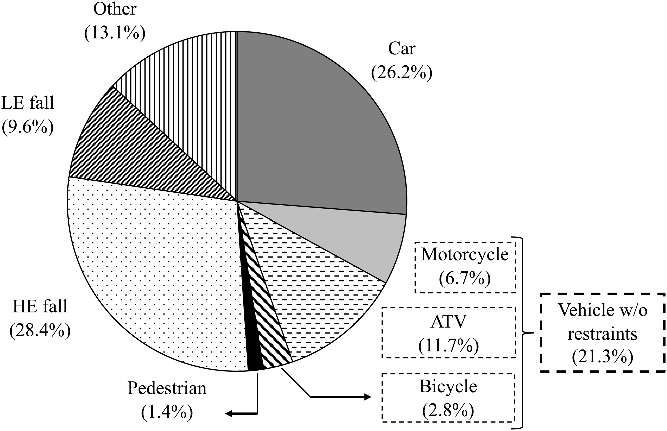
Figure 2: Causes of TSCI associated with spinal fractures.
Table 1: Descriptive data of the study cohort of TSCI patients with fractures
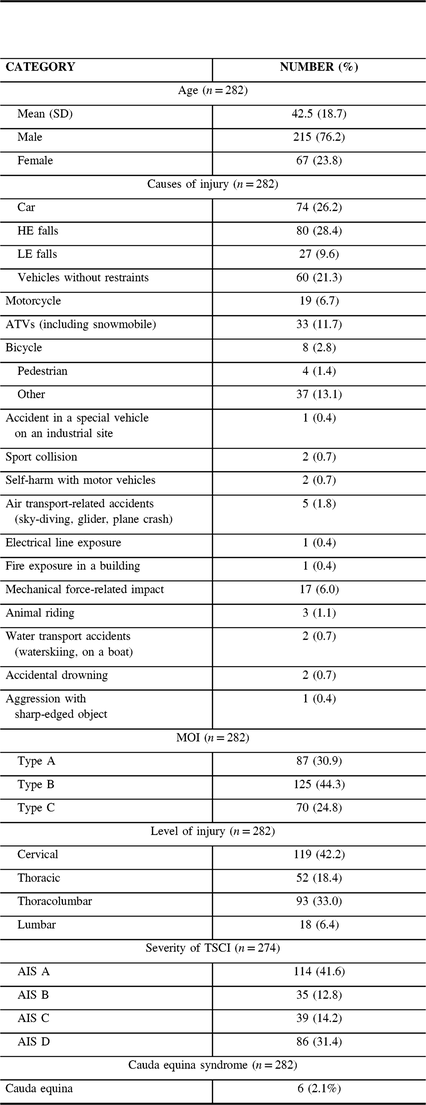
When stratified by age group (Figure 3), car accident (40.0%) was the main cause of injury in patients <20 years. In the 20–49-year-old group, car accidents (34.2%) followed by unrestrained vehicles (27.9%) were the main causes of injuries. In patients >50 years, HE falls (38.9%), LE falls (21.1%) and car accidents (17.9%) were the main causes of injuries.
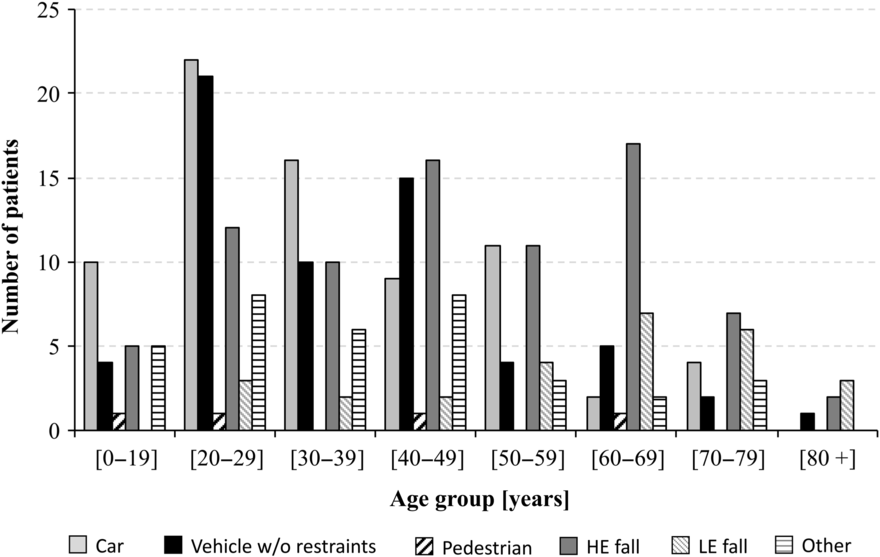
Figure 3: TSCI patients with spinal fractures stratified by age group and causes of injury.
Mechanisms of Injury
In the entire cohort, distraction (type B) was the most common MOI (44.3%), followed by axial compression (30.9%) and axial torsion (24.8%) (Table 2). This tendency, with distraction as the main MOI, is observed in males (Table 3), who account for 76.2% of our cohort. However, in females, axial compression was the main MOI (44.8%), followed by distraction (32.8%) and axial torsion (22.4%) (Table 3).
Table 2: Causes of injury stratified by MOI
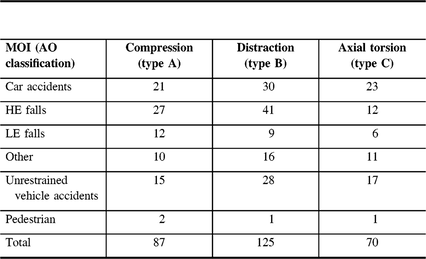
Table 3: MOI divided by gender
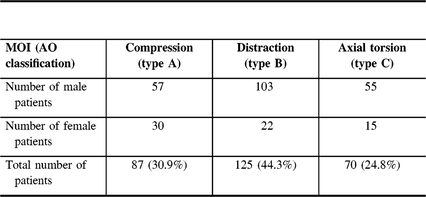
Compression injuries (type A) were mainly caused by HE falls (31.0%), car accidents (24.1%) and unrestrained vehicle accidents (18.4%). Distraction injuries were caused by HE falls (32.8%), followed by car (24.0%) and unrestrained vehicle accidents (22.4%). Axial torsion injuries were most frequently observed in car accidents (32.9%) as well as unrestrained vehicle accidents (27.1%). However, no significant association (p = 0.29) was found between the main MOI and cause of injury (Table 4).
Table 4: Causes of injury stratified by detailed MOI using Aebi (12) and Magerl (11) classifications (from C3 to L5)
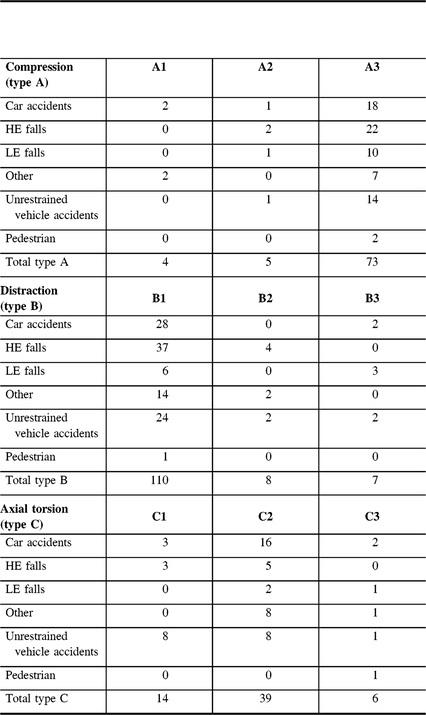
Classification of injuries by subgroups of AO classification in the C3–L5 portion of the spine showed that compression mechanisms due to unrestrained vehicle accidents, car accidents, and falls lead to burst fractures (types A3.1, A3.2, and A3.3) in 87.7% of cases. Type A mechanism was involved in 25% of unrestrained vehicle accidents. Distraction mechanisms mainly caused by falls, car, and unrestrained vehicle accidents led to flexion-distraction injuries with disruption of the posterior ligamentous complex (types B1.1 and B1.2) in 86.4% of cases. Finally, axial torsion mechanisms caused by car and unrestrained vehicle accidents, induced a burst fracture with a rotational injury (type C1.3) in 78.6% of cases. Conversely, a burst fracture (with or without a rotational injury) was involved in approximately one-third (32.7%) of the reported injuries.
Level of SCI
Among 282 patients, the cervical level (42.2%) and thoracolumbar junction (T11, T12, and/or L1 vertebrae) (33.0%) accounted for most spine injuries. The middle part of the thoracic spine (apex of the curve, i.e., T4, T5, and/or T6 vertebrae) (18.4%) and the lumbar spine (6.4%) were rather spared. A significant association (p = 0.021) was found between the injured spinal level (thoracic, from T1 to T10; thoracolumbar, from T11 to L1; and lumbar, from L2 to L5) and cause of injury (Figure 4). In fact, the thoracolumbar junction was the main injury location in 39.1% of unrestrained vehicle accidents, while the cervical spine was affected in 62.5%, 55.1%, and 41.9% of LE falls, car accidents, and HE falls, respectively.
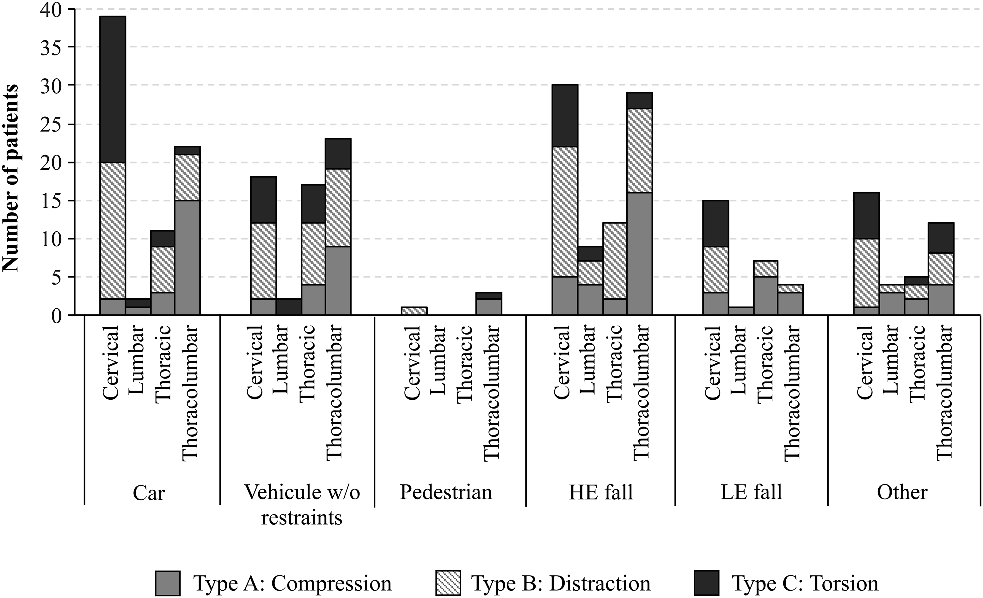
Figure 4: TSCI patients classified by causes, injured spinal level, and injury type.
Moreover, a highly significant association (p = 9.10–10) was found between the injured spinal level and MOI (Figure 5). The thoracolumbar (59.3%) level was the main site of compression fractures, while the cervical level mostly sustained fractures resulting from distraction (48.8%) and rotation (64.3%).
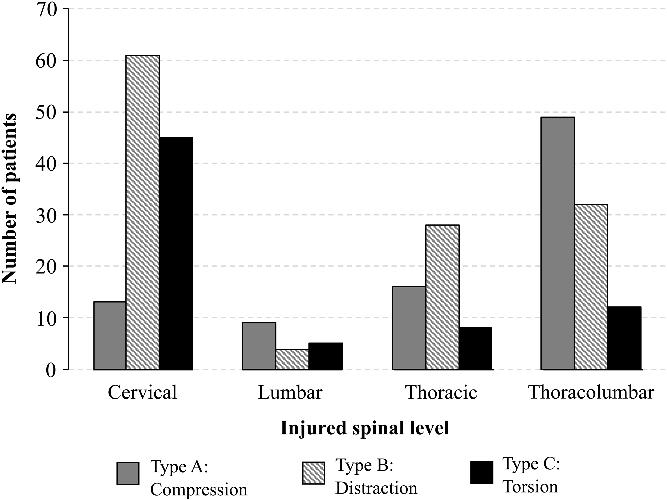
Figure 5: TSCI patients stratified by injured spinal level and MOI.
Severity of SCI
Severity of SCI was documented in 274 patients’ medical files. Using AIS,Reference Magerl, Aebi, Gertzbein, Harms and Nazarian11 114 patients (41.6%) had a complete (A-type) neurological injury, 35 (12.8%) a type B injury, 39 (1.2%) a type C injury, and 86 patients (31.4%) sustained a type D injury. Moreover, six (2.1%) patients had a cauda equina or conus medullaris injury, although they had different AIS grades. Complete motor deficits included AIS types A and B, while incomplete motor deficits pooled types C and D.Reference Magerl, Aebi, Gertzbein, Harms and Nazarian11 A significant association (p = 0.024) was found between motor deficit (complete versus incomplete) and cause of injuries. Car accidents and HE falls showed an even share of 50.7% and 49.4% of complete motor deficits, respectively. However, LE falls led to incomplete motor deficits in 66.7% of cases, while unrestrained vehicles led to complete motor deficits in 67.8% of cases.
Among 274 patients, a significant association was found between deficit severity and MOI (p = 0.0016). Spinal injuries caused by compression resulted in AIS types C or D injuries in 60.5% of cases while spine injuries caused by distraction and axial torsion resulted in an AIS type A or B in 65.6% and 51.5% of cases, respectively.
Discussion
This descriptive study examined TSCI associated with fractures along the spine, with a particular focus on the cause and MOI. Among previous Canadian epidemiological studies providing data on TSCI with spinal fractures, the information was either embedded in groups including TSCI without fracturesReference Lenehan, Street and Kwon3, Reference McCammon and Ethans8 or only had a small number of patients.Reference Pickett, Campos-Benitez, Keller and Duggal4, Reference Leucht, Fischer, Muhr and Mueller9 To our knowledge, this study has the largest cohort of severe TSCI with fractures in Canada and relates causes, mechanisms of injuries, and injured spinal levels. TSCI with spinal fractures represent 44% of all TSCI treated at our medical center (data not shown) and generally lead to more severe neurological deficits. This percentage, collected over an 8-year period, was below that figure (64%)Reference Pickett, Campos-Benitez, Keller and Duggal4 estimated in other level I trauma centers in Canada and other countries, possibly due to our specific inclusion criteria. Indeed, our data required the presence of CT-scan imaging modality to classify TSCI associated with fracture. Cervical injuries represent a high percentage of all TSCI,Reference Lenehan, Street and Kwon3, Reference Dryden, Duncan Saunders and Rowe7 although the specific percentage attributable to either C1 or C2 levels is not reported.
Young and Middle-Aged Population at Risk of TSCI with Fractures
The male-to-female ratio in our group of interest is consistent with previous studies on TSCI in CanadaReference Couris, Guilcher and Munce1, Reference Pickett, Campos-Benitez, Keller and Duggal4, Reference Guilcher, Munce and Couris6, Reference Dryden, Duncan Saunders and Rowe7 and other developed countries.Reference New, Simmonds and Stevermuer17, Reference Hagen, Rekand, Gilhus and Gronning18 The mean age of our cohort (42.5 ± 18.7 years) was slightly lower than those reported in studies including all TSCI spinal levels, with or without evidence of spinal fractures (51.3 ± 20.1 yearsReference Couris, Guilcher and Munce1; 46.9 ± 17.3 yearsReference Guilcher, Munce and Couris6; 42.2 ± 20.9 years, range 9–96 yearsReference Pickett, Campos-Benitez, Keller and Duggal4). Indeed, older patients are more prone to sustaining a cervical TSCI without evidence of a fracture.Reference Bárbara-Bataller, Méndez-Suárez, Alemán-Sánchez, Sánchez-Enríquez and Sosa-Henríquez2, Reference Pickett, Campos-Benitez, Keller and Duggal4 As the presence of fracture was an inclusion criterion of this study, the second incidence peak, generally observed in all male TSCI (with and without fracture) patients aged >60 years,Reference Pickett, Campos-Benitez, Keller and Duggal4, Reference Dryden, Duncan Saunders and Rowe7 was not found in our study. Our data also did not show a clear second peak in females 60–69 years old, which could be explained by the low number of female patients (only 14) >60 years. Indeed, in this age group, TSCI are mostly due to HE and LE falls. Lower bone quality in postmenopausal femalesReference Macdonald, Nishiyama, Kang, Hanley and Boyd19 could explain the presence of fractures associated with TSCI in this specific age group.
Lack of Association Between Causes and MOIs
In this study, no association was found between causes and MOI. Indeed, the choice of broadly defined categories might have masked the specificities of potential associations between causes and MOIs. However, this choice was justified by the small cohort. Moreover, refining the causes category should not be limited to the dissociation of different means of transportation such as bikes and motorcycles, within the vehicle without restraint system category. Categories should also include key indicators or potential predictors of the nature and gravity of an accident,Reference Matsui, Oikawa, Sorimachi, Imanishi and Fujimura20 such as kinematic data (angle, position, velocity, acceleration) at impact. These kinematic variables are impossible to measure once an accident has occurred. Future research is, therefore, required to investigate the relationship between causes of accident and kinematic data, through the combination of experimental and numerical approaches of full-scale crash reproduction.
Vehicles Without Restraint Systems, One of the Leading Causes That Could Be Acted Upon
Our study revealed that vehicle accidents, which regrouped both car and unrestrained vehicle categories, were responsible for about 50% of TSCI associated with a cervical, thoracic, or thoracolumbar fracture. Indeed, motor vehicle collision, pooling cars and unrestrained vehicles categories, was recognized as the leading cause of TSCI in Canada,Reference Lenehan, Street and Kwon3, Reference Pickett, Campos-Benitez, Keller and Duggal4, Reference Dryden, Duncan Saunders and Rowe7, Reference McCammon and Ethans8 accounting for 35–56.4% of all TSCI, and worldwideReference Lee, Cripps, Fitzharris and Wing21 with a proportion of 22% (excluding Greenland) up to 72%, closely followed by falls affecting an older population and often causing a TSCI without fracture.Reference Pickett, Campos-Benitez, Keller and Duggal4 Our study further showed that nearly half of vehicle collisions were ATV and motorcycle accidents, mostly affecting the 20–49 age group and were associated with severe neurological deficits (AIS A or B) in almost two-thirds of cases. Previous studies also highlighted a high incidence of vehicle collision-related TSCI with or without fractures in the youngReference Pickett, Campos-Benitez, Keller and Duggal4, Reference Dryden, Duncan Saunders and Rowe7, Reference Wang, Liu and Zhao13 and middle-aged population.Reference Pickett, Campos-Benitez, Keller and Duggal4 More specifically, in Ontario, Canada, Pickett et al. found that off-road vehicles caused more than a third of thoracic spinal cord injuries always associated with fractures.Reference Pickett, Campos-Benitez, Keller and Duggal4 They also mentioned a decrease in TSCI caused by motor vehicle collisions among the young population, which could potentially be attributed to the THINK FIRST Head and Spinal Cord Injury Prevention Program.Reference Pickett, Campos-Benitez, Keller and Duggal4 This decrease pooled both motor vehicle and unrestrained vehicle categories, and no information was provided concerning the percentage of contribution of each subgroup. Unrestrained vehicle users seem to be particularly at risk in the province of Quebec, which is interesting considering the seasonal use of ATVs and motorcycles (6–8 months per year) due to weather and road conditions. Compared with other Canadian studies,Reference Couris, Guilcher and Munce1, Reference Lenehan, Street and Kwon3, Reference Dryden, Duncan Saunders and Rowe7 unrestrained vehicles were not identified as a main category and usually pooled with motor vehicles. Contrary to cars, ATVs and motorcycles have no restraint system (e.g. seatbelt) to protect their users, while functional damages can severely impair life quality. Currently, prevention strategies are mostly based on user awareness. The regulation imposes the use of a helmet for motorcyclists only, and no other protection equipment is mandatory for users such as bicycle riders. Back protectors, including hard-shell devices and/or jackets with airbags, are emerging devices in the market,Reference Giustini, Cedri, Tallon, Roazzi, Formisano and Pitidis22 and should be designed to protect users from the main mechanisms of injuries. Moreover, there is a lack of regulation concerning protection effectiveness, as the EN1621-2 European standard constitutes the sole certification for back protector design and only assesses impact force reduction.Reference Ekmejian, Sarrami, Naylor and Harris23 Hence, additional research on safety equipment is required to ensure these provide adequate protection in crash scenarios encountered on the roads,Reference Ekmejian, Sarrami, Naylor and Harris23 especially for ATV, motorcycle and bicycle users.
MOI Mainly Involve Cervical and Thoracolumbar Spinal Levels
Vehicle collisions were associated with type B injuries (40.5%), followed by types C (31.1%) and A (28.4%), and mostly affected the cervical (types B and C) and thoracolumbar (type A) spinal segments. This result is in line with Ekmejian et al. who found that a combination of bending and twisting was the main mechanism causing the most serious back injuries.Reference Ekmejian, Sarrami, Naylor and Harris23 Our study was retrospective and only reported the main MOI. It did not account for possible combinations of MOI. Acquiring a better understanding of MOI involved in TSCI is critical to adequately decide prevention strategies. This study highlights the lack of efficient protection of cervical level against types B and C mechanisms, and of thoracolumbar level against type A. It also showed that vehicles without restraint system users are at risk of TSCI with fractures and severe neurological impairment, but do not have adequate spinal protection. Currently, bicycle and motorcycle helmets only cover the head and a small portion of the upper cervical spine, and there could be a need to develop specific cervical and thoracolumbar devices to reduce injury severity.
Limitations
Data collection bias is one of the limitations of this retrospective study. We screened our internal database to identify TSCI cases with fractured vertebrae along the spine. More recent AO classifications published by Reinhold et al.Reference Reinhold, Audigé, Schnake, Bellabarba, Dai and Oner24 and Vaccaro et al.Reference Vaccaro, Koerner and Radcliff25 for the thoracolumbar and cervical subaxial spinal levels, respectively, were developed although not used in this study. Changes compared to the original Magerl et al.Reference Magerl, Aebi, Gertzbein, Harms and Nazarian11 and Aebi et al.Reference Aebi, Arlet and Kebb12 classifications were minor. Concerning the C1–C2 levels, the most recent Upper Cervical Classification System15 was used, although this system is not validated and no subgroups defined. Moreover, only patients with CT-scan images could be included to obtain information about MOI. An expert orthopedic surgeon identified fracture types based on CT-scan images, but his decisions were not challenged by another expert. Cases that were not appropriately coded with respect to the ICD, AO classification, or ASIA impairment scale were carefully reviewed using the clinical charts of patients. Charts with missing data were excluded from the study, reducing our sample size, which also constitutes a limitation. The small number of patients is limiting, as it increases our type II error if too many categories are compared, for example, concerning accident causes or time-related changes in terms of age and MOI. However, our study is encouraging to pursue further research to improve vehicle without restraint system security.
Conclusion
In light of our study providing knowledge of current epidemiological trends on TSCI with fractures in a single, level I trauma center in the province of Quebec, we found that a young active population is specifically at risk of severe neurological impairment and that vehicles without any restraint system are one of the leading causes. Future research should further investigate the accident patterns of unrestrained vehicle category to improve preventive measures.
Acknowledgements
The authors would like to thank Solenne Lefèvre for her technical help. This study was funded by the Natural Sciences and Engineering Research Council of Canada and the J.A. De Sève Foundation of Hôpital du Sacré-Coeur de Montréal.
Conflict of Interest Statement
There is no conflict of interest regarding this work.
Statement of Authorship
All authors have made substantial contributions to this paper: conception and design of the study (EW, J-MM-T, P-JA, YP), acquisition of data (J-MD), data analysis and interpretation (EW, J-MD, A-LM, YP), and writing of article (EW, A-LM). All authors revised and approved the final version of the manuscript.











